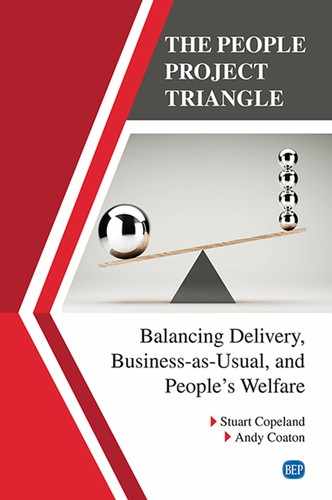This has been a practical book advocating a particular approach for a particular type of business project that changes the way business-as-usual is done.
The modern business environment is one of rapid change. The modern corporation is lean and very cost conscious. A consequence is an increasingly common project management situation of a medium important, medium complex business change project that cannot justify a full-time team. Instead, these projects are staffed by in-house resources working on the project in addition to their normal responsibilities. We term these as-homework staff, and the projects, composite projects.
The thesis of the book is that:
- 1. Composite projects are being used at an increasing rate to meet the demands of rapid business change.
- 2. They are largely unrecognized as a separate organizational category of project with particular characteristics, management needs, and risks.
- 3. We maintain that there is a people project triangle with trade-off between the project, ongoing business, and people working in both the business and the project. When pressure mounts, generally, only two of those can be prioritized, and one must give. We observe that it is often the people who bear the brunt with subsequence implications of stress, burnout, and damaged reputations.
- 4. However, with better recognition, clearer understanding, and appropriate measures, many of the common problems with composite projects can be foreseen and mitigated or avoided, and we have provided our suggestions.
We provided a framework for identifying when composite projects can be used. Then, a series of chapters recommending practical techniques and approaches for dealing with the issues specific to composite projects.
The Right Approach
The right approach is a mentality of stakeholder-driven rather than methodology-driven. The stakeholder-driven project manager understands projects are done by people and impact other people such as the managers of the as-homework project staff. Consequently, they develop soft skills concerning understanding people and relationships in addition to the methodology project management skills.
Effective and Effective Use of the Sponsor Is Key
Leverage the hierarchical power and credibility of the sponsor to secure budget, free up resources, and focus project teams. Use them in communications to affect the greatest attention.
Understand the Team
The project needs to be done by the project staff, so understanding the individuals is vital: their motivations, skills, limitations, including those imposed by their BaU managers.
Realize that the BaU managers, although not in the team, can have a major impact on the project. So, understand them and their issues, involve them, and help them to feel engaged and contributing to the project success.
Do not expect the group to be effective automatically. They need to be forged into a team. Start by inspiring them with a vision of the positive change the project will deliver.
Respect People’s Time
Time is the key scarce resource of as-homework staff, so do not
squander it.
Communication
Plan and tailor as-homework staff communication for them. Use media and language appropriate for them. Communicate frequently and succinctly. Do not alienate them with information they do not need and are not interested in; otherwise, they will ignore it and miss vital information. Make further information available for them if they are interested.
Have effective and efficient meetings: appropriate size, attendees, agenda, allow part and remote attendance.
Methodology
Keep things simple, adapt the methodology for the skill levels and time limitations of your team. Make it easy for staff, do not expect them to sub-divide their work. Instead, issue small frequent deliverables.
The Day Job
Be keenly aware of the day job pressures, not in general terms, but specifically. This allows you, where possible, to plan the project around them. Also, be very clear of the project dependencies so that you can know when and what to flex and still meet critical timescales.
However, sometimes, the day job issue must be confronted and time on the project preserved. This is another time the sponsor might be key.
Finally
These recommendations based on our experience are summarized in Figure 19.1. We hope that this book can start a debate about the nature and specific problems of composite projects. We look forward to hearing other people’s research and experience and adding them to our toolkit.
Figure 19.1 Summary of advice specifically for composite projects
